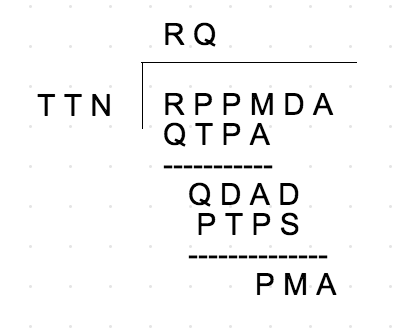Cryptarithmetic Division Problem 4

You must know Cryptarithmetic Multiplication first to be able to solve these, so we suggest studying Multiplication problems from our website first.
The first thing to do in this problem to break down into Multiplication and Subtraction problem as follows –
We have not been able to solve this question, please provide answer in comments or you can try other problems listed on the main page of Cryparithmetic Division Problem all others are solved completely.
Breaking down the problem -
T T N
x R
------- - 1
Q T P A
T T N
x Q
------- - 2
P T P S
R P P M
- Q T P A
--------- - 3
Q D A
Now lets take equation number 3
From 10's digit we see that P - P = D,
Thus it is clear that value of D = 0
and possible values of P can be = {1,2,3,4,5,6,7,8,9}
Now, Learn this Cryparithmetic Subtraction Rule -
If, X - A = A,
Then X = {2, 4, 6, 8}
A = {1, 2, 3, 4}
Thus, in our case M - A = A
So, they will have values,
M = {2, 4, 6, 8}
A = {1, 2, 3, 4}
Now, lets do hit and trial method,
D = 0, M = 2, A =1
So, possible values for P = {1,2,3,5,6,7,9}
R is not 1 as R > Q and if R is 1 then there is no value of Q.
Let us assume P = 5
R 5 5 2
- Q T 5 1
---------
Q 0 1
Since, R - Q is 0. Thus, R and Q must be consecutive.
i.e. R = Q + 1
Possible values for R and Q can be =
{(7,6)}
As, (1,2) not possible as (M,A) are there.
As, (2,3) not possible as M is 2
Next consecutive value are (5,6)
P is already 5
So (R,Q) cant be (6,5)
If (P,Q) = (7,6)
7 5 5 8
- 6 T 5 4
---------
6 0 4
Now, for 5 - T = 6
T = 9, thus possible.
Putting these in Eq - 1
9 9 N
x 7
-------
6 9 5 1
Since, N x 7 = _1. Thus, N = 3(as 21)
Putting all these values
_________
9 9 3 |7 5 5 2 0 1
6 9 5 1
-------
6 0 1 0
5 9 5 S
--------
5 2 1
Clearly S = 8
Thus, we have found all values.




T T N = 993
R Q = 76
Q T P A = 6 9 5 1
P T P S = 5 9 5 8
R P P M D A= 7 5 5 2 0 1
Full solution please